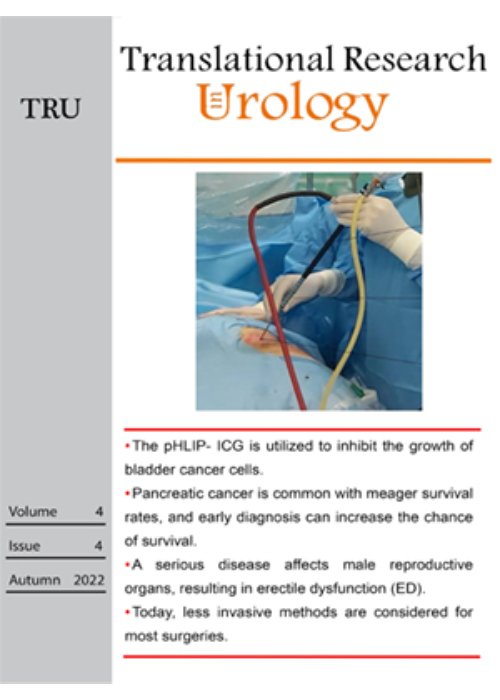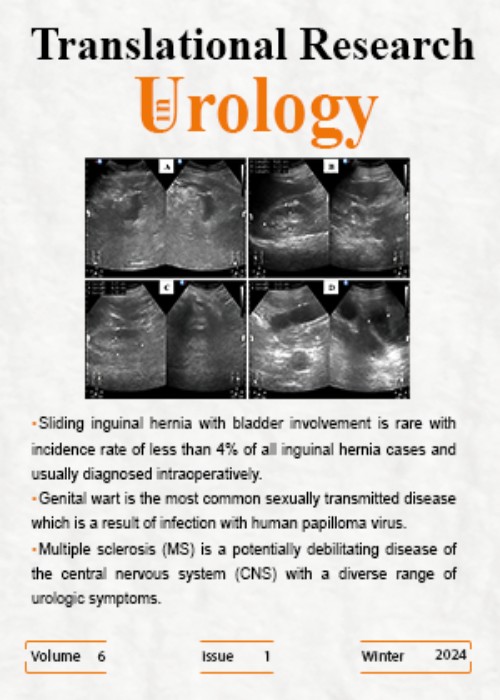فهرست مطالب

Journal of Translational Research in Urology
Volume:4 Issue: 4, Autumn 2022
- تاریخ انتشار: 1401/09/19
- تعداد عناوین: 8
-
-
Pages 151-153
Fluorescence imaging is being used in a variety of new surgical uses. Many innovative fluorescent probes and imaging plans are also being advanced as part of the technology. The Low-pH insertion peptide (pHLIP) technology may offer numerous methods for progressively managing urinary tract cancers. For diagnosis and transurethral resection of bladder cancer, pHLIP-Indocyanine green (pHLIP-ICG) has been used inside the bladder, and pHLIP-amanitin has been utilized to inhibit the growth of bladder tumor cells.
Keywords: pHLIP, Bladder Cancer, Fluorescent Imaging -
Pages 154-157Introduction
calcium oxalate, phosphate, struvite, uric acid, and cysteine make up the majority of urinary stones. Moreover, only 0.5 -3.5 percent of urinary stones have a different composition. A thorough history, physical examination, along with urinary stone analysis helps to diagnose the cause of rare urinary stones.
Case presentationWe herein report a case of pancreatic cancer with the unusual presentation of renal colic and ureteral stones. After removing the stones with ureterolithotripsy, the stone analysis revealed bilirubin crystal composition. Upon further follow-up, the patient has diagnosed with adenocarcinoma of the head of the pancreas.
ConclusionsThis case highlights the importance of stone analysis, while many urologists do not consider this, and this is my result in miss diagnosis of some dangerous diseases that may present with the uncommon presentation.
Keywords: Renal Stone, Pancreatic Adenocarcinoma, Ureteral Stone, Biliary -
Pages 158-166
The newly severe acute respiratory syndrome coronavirus caused by the coronavirus pandemic 2019 (COVID-19) resulted in 150 million infections and 3.5 million deaths worldwide. COVID-19 influenced men more than women, with more severe disease and higher mortality rates. A serious illness affects male reproductive organs, resulting in erectile dysfunction (ED). Although the exact pathophysiology of this disease has not been entirely determined yet, this review highlights the possible mechanisms of COVID-19-related sexual disorders led by COVID-19. In summary, the research shed light on COVID-19 infection can influence men’s sexual performance via endothelial harm in erectile tissue, testicular damage, and mental changes. Still, longitudinal studies should be performed to determine the mechanism of COVID-19 in ED.
Keywords: Coronavirus, COVID-19, Heart, Blood Vessels, Sexual Disorders, Erection -
Pages 167-172Introduction
Kidney cancer is currently the 9th most common cancer in men and the 14th most common in women. Renal cell carcinoma (RCC) is the most common type of kidney cancer, accounting for about 85% of all renal malignancies. It accounts for about 2% of diagnoses and deaths following all cancers. Several risk factors for RCC include smoking, obesity, hypertension, and acquired cystic kidney disease.
MethodsThis cross-sectional study was conducted on patients who underwent nephrectomy (partial nephrectomy or radical nephrectomy) due to kidney mass from 2018 to 2021. Patients whose final pathology was RCC remained in the study, and patients with other pathologies were excluded. Risk factors and frequency of RCC pathological subtypes were investigated.
ResultsThe most common subtype was Clear Cell (60.1%), followed by Papillary (19.7%) and Chromophobe (18.7%). Most patients were men and overweight, with a mean body mass index (BMI) of 27.19 ± 4.68. Hypertension and Diabetes are considered independent and strong risk factors in RCC development. In terms of grading using the Furman grading system, grade 2 was significantly higher than other grades (51%).
ConclusionsConsidering the frequency of different sub-types of RCC in our study, it seems different from the global dispersion pattern. Unlike previous studies, blood type did not play a proven role in causing RCC in our research. In contrast, the role of other risk factors, such as a history of Diabetes, hypertension, smoking, and obesity, was proven.
Keywords: Chromophobe Renal Cell Carcinoma, Clear Cell Renal Cell Carcinoma, Nephrectomy, Papillary Renal Cell Carcinoma, Renal Cell Carcinoma -
Pages 173-179Introduction
This study aims to evaluate Under Vision Total Tubeless PCNL (TT-PCNL) as a novel technique in reducing surgeon exposure to X-rays compared to the standard Total Tubeless PCNL. Percutaneous nephrolithotomy (PCNL) has been widely welcomed as a less-invasive medication for kidney stones. However, because it is usually performed using fluoroscopy, the endourologist is at risk of chronic X-ray exposure.
MethodsThe number of 76 consecutive patients who were candidates for PCNL surgery was randomized into two groups: 38 patients experienced TT-PCNL, and 38 patients underwent Under Vision TT-PCNL. The results were compared with fluoroscopy time and surgeon satisfaction.
ResultsThe fluoroscopy time in the Under Vision TT-PCNL group was lower than in the Total Tubeless PCNL group (0.02). Surgeon satisfaction was higher in the Under Vision Total Tubeless PCNL group than in the TT-PCNL group (P-value=0.001). The mean total duration of surgery in the TT-PCNL under the Vision group was lower than the Total Tubeless PCNL group (P-value=0.04). There was no significant difference between the two groups' complications.
ConclusionThe Under Vision TT-PCNL is compared to the normal PCNL in safety and effectiveness, but also it can significantly reduce the use of a fluoroscope. Moreover, surgeon satisfaction is better compared to the standard technique.
Keywords: Renal Stone, PCNL, Fluoroscopy, Under Vision, Stone Free Rate, KidneyStones -
Pages 180-186Introduction
This study aimed to evaluate how silver nanoparticles, in conjunction with black seed and honey, affected alterations in serum, urine, and renal variables in male mice with renal stones.
MethodsOur study considered four target groups: negative and healthy control groups, 125ppm silver nanoparticles treatment, 125mg/kg black seed with 125mg/kg honey, and 125ppm silver nanoparticles treatment. We introduced essential ingredients to the groups from the first to the last day of the experiment, adding 1% ethylene glycol to the drinking water. The researchers investigated serum variables, such as potassium, sodium, calcium, phosphorus, and magnesium, urine factors like citrate, oxalate, and calcium, and tissue factors like kidney weight and crystal count.
ResultsThe results of this paper revealed that the accumulation of calcium oxalate crystals in the treatment group with 125ppm of silver nanoparticles significantly increased compared to other groups (P-value<0.001). Biochemical examination of urine showed that urine oxalate in the group treated with 125ppm of silver nanoparticles increased by (0.03±0.78) and in the combined group of honey and black seeds (125mg/kg) and silver nanoparticles (125ppm) increased by (0.05±0.54). It shows significance (P-value 0.001). In addition, the results of changes in serum and tissue parameters in both groups showed that they aggravate the formation of kidney stones.
ConclusionsAccording to the findings of this research, silver nanoparticles cause toxicity in serum, urinary, and kidney tissue factors. Therefore, they are not a suitable option for preventing and treating kidney stone patients.
Keywords: Serum, Urinary Factors, Kidney Stones, Silver Nanoparticles, Honey, Black Seed -
Pages 187-194Introduction
MicroRNAs can regulate expression of gene by binding to 3'-UTRs (untranslated region) of mRNAs. Genetic changes in miRNA binding domains affect susceptibility to various diseases, including cancer. This research presented to determine the impact of pri-miR-34b T> C rs4938723 and miR34a A>C rs6577555 polymorphism in renal cell carcinoma.
MethodThis case-control study has been done on 100 patients with RCC and 100 healthy matched control in two referral urology centers in Tehran, Iran. The miRNA-34a/b polymorphisms mentioned in the genomes of healthy individuals and patients with RCC were studied by the tetra arms PCR method. Then statistical studies were performed by SPSS software, using the independent sample T-test and Chi-square. A P-value lower than 0.05 is significant.
ResultsThe connection between pri-miR-34b T>C and miR34a A>C variants were considered according to age, sex, tumor site, metastasis site, tumor stage, and tumor grade in this study. No statistically significant difference existed between the two study groups regarding gender and age. Smoking and alcohol consumption were significantly higher in RCC patients, so we suggest them as the main risk factors. The rs6577555 polymorphism showed a significant association with the classification of tumor type (P-value=0.047), but rs4938723 SNP did not correlate with the tumor type.
ConclusionsThe findings indicated that rs4938723 and rs6577555 polymorphism might be a risk for predisposition to RCC in the population of Iran. More research with greater sample sizes and various ethnicities must approve our findings.
Keywords: miRNAs, Risk Factor, Cancer, Renal Cell Carcinoma -
Pages 195-202Introduction
Radical cystectomy (RC) is recognized as the standard gold treatment for patients with high-risk muscle-invasive bladder cancer (MIBC) and non-MIBC (NMIBC). Admission and adoption of early recovery protocols following RC (ERPRC) are highly variable throughout the world. We sought to examine current practice patterns and adherence to early improvement pathways in the perioperative management of RC through a survey administered to national urologists.
MethodsWe conducted a multicenter cross-sectional study through a survey that addressed different components of the ERPRC. Two authors (ABS and JNP) reviewed the available ERPRC evidence. The questionnaire included 24 questions. Participants provided consent, and their anonymity was assured.
ResultsSixty-six responses were gathered from 17 centers. 64% of the respondents mentioned not having a formal ERPRC in their center. However, high-volume cases showed a significantly higher ERPRC implementation rate (51.5% vs. 10.5% vs. 0%, P-value<0.05). In the preoperative period, anemia correction and avoidance of bowel preparation were the most implemented steps. Intraoperatively, urologists tend to follow ERPRC recommendations in the postoperative period. No statistically significant differences were found in ERPRC components adopted in the perioperative period and the median length of hospital stay (9 days, P-value=0.09), irrespective of surgical center volume. ERPRC is agreed by 77% of urologists to be useful or very useful for achieving better outcomes.
ConclusionsAlthough most of the urologists pointed out that ERPRC was not formally implemented at their center, most parts indicated that ERPRC significantly improved outcomes during RC PO and, therefore, were followed.
Keywords: Bladder Cancer, Muscle-Invasive Bladder Cancer, Early Recovery After Surgery, ERAS, Protocol


